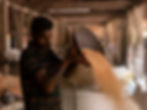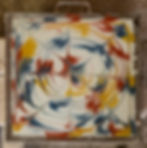The Making of Unique Athangudi Tiles : An Unforgettable Experience
- Naseef T. P
- Oct 1, 2023
- 4 min read
Updated: May 16, 2024
Chettinad, the land of wealthy Chettiars in the southern part of Tamil Nadu, is famous not only for its mouth-watering cuisine but also for its palatial houses, arts, crafts, and weaving. It was a long-time desire to visit Chettinad. The main things that attracted me were its mansions and the handicraft village of Athangudi. I visited there to photograph an old Chettinad house in Kanadukathan. The three-day stay in that heritage village and its sights were unforgettable. Even today, Chettinad has the visual beauty that makes anyone attracted who has visited that place.
From Kanadukathan, we traveled by car to the handicraft village called Athangudi. It was the feeling of going through a village in Kerala, during my childhood. There are small houses and herds of cows on both sides of the road. In between the palace-like houses standing tall to the blue sky with the pride of tradition. I started seeing the advertisement boards of many tile manufacturing centers signaling that Athangudi had arrived. About 50 villages are involved in the production of Athangudi tiles, also known as Chettinad tiles. Countless companies were here. Now, their number has increased to a large extent due to the increase in the number of customers.

Gopi Chetan (Meaning Brother in Malayalam) stopped the car in front of Sri Ganapati tile work. A brief description of the manufacturing unit was also given by him. After I started shooting Benny sir's projects, that's when my love for Athangudi tile began.The floors, verandas, and risers of the stairs of many of those houses designed by Dr. Benny Kuriakose all shine with the splendor of Athangudi tile tradition. Athangudi tiles are known for their colorful and intricate patterns. Most of the Chettinad mansions have colorful handmade Athangudi tiles on the floors. I have heard Benny sir describe many of its features, like hand-made tiles, which are eco-friendly and lasts for decades. Ever since then, I wanted to go to that village of those craftsmen and see those artists and its construction first hand. When we reached Athangudi, his heart was filled with wish fulfillment. Natarajan, the supervisor, took us inside the tile manufacturing unit to see it. There were six or seven employees there. Tiles are made using river sand and cement. When you enter, the first thing you see is behind the scenes.
A young man takes a pot full of sand in his hand and, with the help of a fan, adds sand. Nearby, the synthetic die oxide color powder mixing mesh is rotating, and the work related to it is being done by the young man himself. Nearby, someone is mixing green and red colors in a bucket. I asked him 'why this is being done', with a loving invitation. Sholayan Annan (meaning brother in Tamil), who has been in tile making for 30 years, explained and demonstrated each step of tile making.


Tile-making starts with a 5 mm glass base. An outer frame establishes the dimensions of the tile and is placed on top of the foundation. A brass pattern mold is mounted on top of the frame, specially designed to survive wet tile manufacturing environments. Next, colors are poured into the mason frame as per the design.

The process of pouring color is a bit complicated. Red, yellow, green, and blue colors are mostly used. It is poured into the design grill in different rhythms using hand from the mixing bowl. It is done by experienced artists.


After laying the color layer, a dry mixture of sand and cement is spread on top. Athangudi village is famous for its unique sand. Flakes of mica and silica add shine and smoothness to the tiles. The mason then fills the rest of the mold with a wet mortar of cement, sand, and water. Finally, they compress the tile with a plate, which provides a smooth, firm base for a seamless finish.

The tiles are left to dry in the evening and then soaked in water the next day for up to three days. Depending on the weather and season, the drying process can take anywhere from one to three weeks.

Once the tile is dry, the tile worker removes the glass from the tile and dries it. The glass is usually washed with water and a small amount of sulfuric acid to remove stubborn residue. The mason sands the edges of each tile to remove rough spots and stores the finished product in stacks.

Similarly, free designs are also done without using a frame design grill. It is a fun and interesting process. The scene where the color is poured on the frame as dots and painted with the fingers is a must-see. They are beautiful designs that captivate the viewer so much that we bow before the artist's handwork. Workers say as many as 1,000 designs are possible. Many of the designs are very similar to Victorian tiles used in the late 19th century. The design can be plain and exotic with floral patterns or free styles, depending on the style we want. The patterns are made according to the needs and wishes of the customer. As each tile is individually handcrafted, the slight variation in design becomes the signature feature of these tiles.



Economically affordable in design and finish, Chettinad tiles can match any modern tiles available. The Athangudi tile manufacturing process involves no firing and no use of electricity, so it is more sustainable compared to alternatives like ceramic tiles. These tiles are durable and a symbol of tradition and modernity.

For more articles, visit the following links:

















